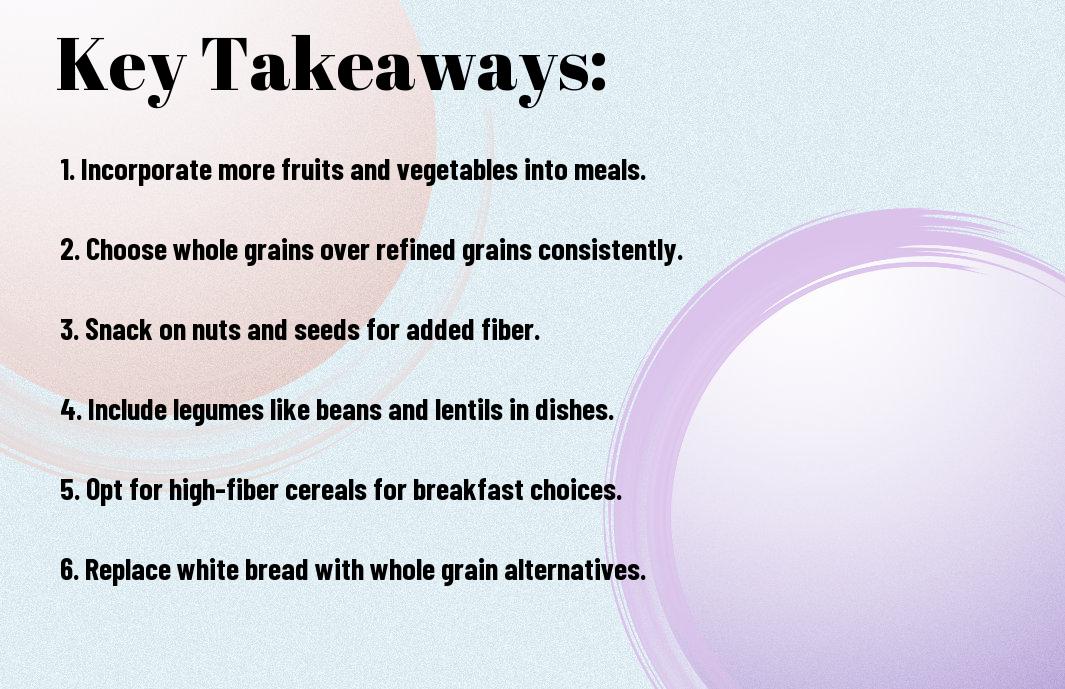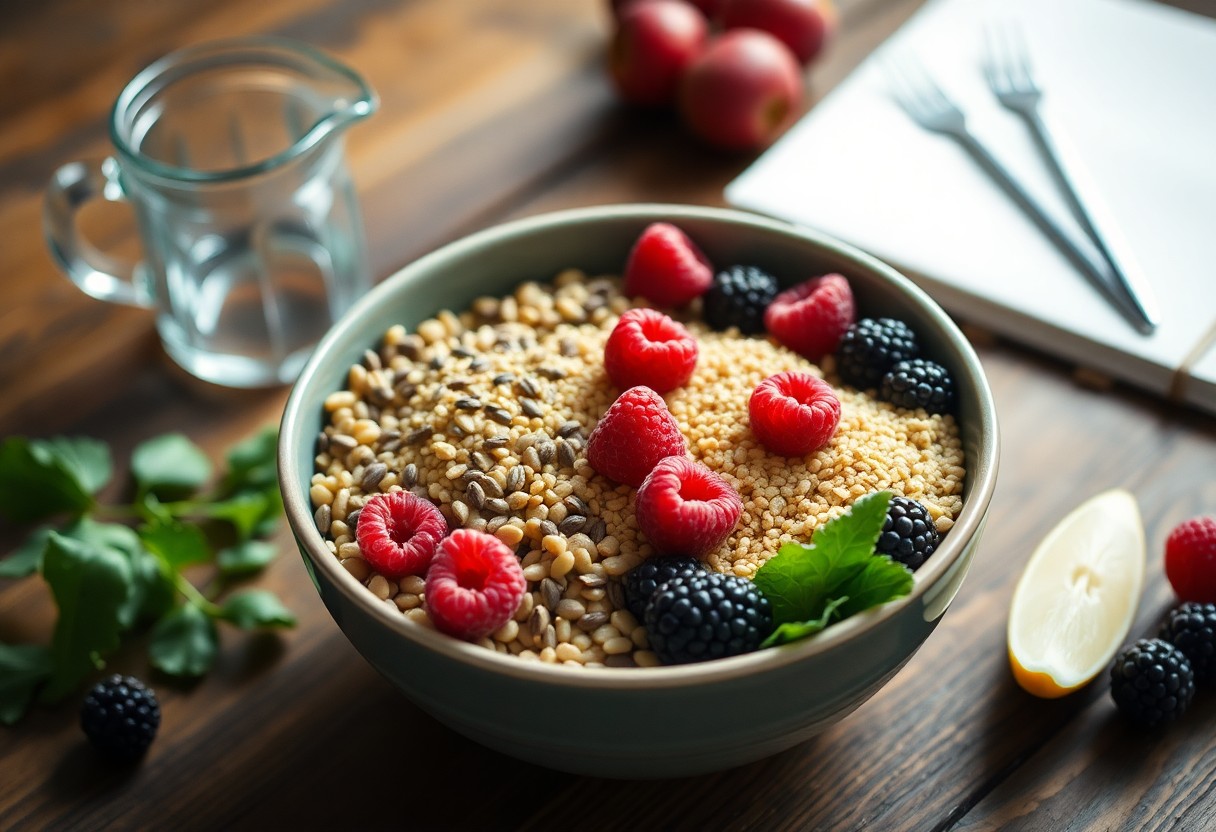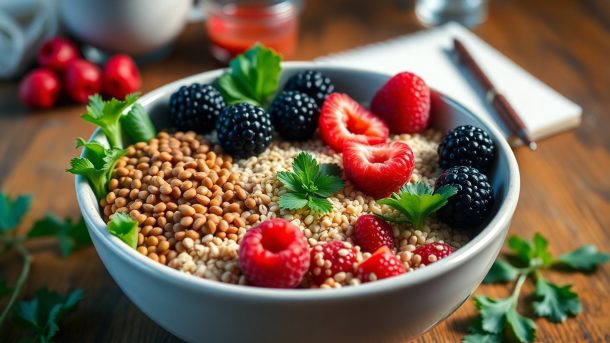With the rising awareness of the benefits of dietary fibre, you may be looking for ways to boost your intake quickly. Increasing your fibre can improve digestion, support weight management, and enhance overall health. In this guide, you’ll discover practical tips and food options that will help you increase your fibre intake efficiently, allowing you to reap the benefits without feeling overwhelmed. Embrace these strategies as you work towards a healthier lifestyle and enjoy the advantages that come with increased fibre in your diet.
Key Takeaways:
- Incorporate High-Fiber Foods: Adding foods such as beans, lentils, whole grains, fruits, and vegetables to your diet can quickly boost your fiber intake.
- Choose Whole Grains: Swap refined grains for whole grains like brown rice, quinoa, and whole-grain bread for an immediate increase in fiber levels.
- Snack Smart: Opt for snacks like nuts, seeds, or popcorn, which are not only tasty but also provide a good source of dietary fiber.
Understanding Dietary Fiber
Your diet plays a significant role in ensuring adequate fiber intake. Dietary fiber consists of plant-based carbohydrates that your body cannot digest. It is classified into two main types: soluble and insoluble fiber, each offering unique health benefits. By understanding fiber, you can make informed dietary choices to enhance your overall health.
Types of Fiber
Your fiber intake includes different types, each with distinct properties and benefits:
- Soluble Fiber: Dissolves in water and helps lower cholesterol.
- Insoluble Fiber: Does not dissolve in water and supports digestive health.
- Fermentable Fiber: Can be fermented by bacteria in the gut and promotes gut health.
- Functional Fiber: Added to foods for health benefits.
- Dietary Fiber: Naturally found in whole foods like fruits and vegetables.
The variety of fiber types available can enhance your health in multiple ways.
| Type of Fiber | Source |
|---|---|
| Soluble Fiber | Oats, beans, apples |
| Insoluble Fiber | Whole grains, nuts |
| Fermentable Fiber | Chicory root, asparagus |
| Functional Fiber | Psyllium husk, inulin |
| Dietary Fiber | Vegetables, fruits |
Health Benefits of Fiber
Dietary fiber is associated with numerous health benefits, including improved digestion and reduced risk of chronic diseases. It can help control blood sugar levels, promote a healthy weight, and enhance gut health through regular bowel movements.
With an adequate intake of fiber, you not only support your digestive health but also provide your body with important nutrients. Studies have shown that fiber-rich diets can lower the risk of heart disease, diabetes, and certain types of cancer. By incorporating more fiber into your meals, you can enjoy these preventive benefits while optimizing your overall health. So, consider adding fiber-rich foods to your diet for improved well-being.


Assessing Your Current Fiber Intake
Assuming you want to increase your fiber intake quickly, the first step is to assess your current consumption. Start by keeping a food diary for a week to track the total amount of fiber in your meals and snacks. Most adults should aim for a specific daily target, and knowing where you currently stand will help you identify gaps in your diet and set realistic goals for improvement.
Common Sources of Fiber
Around your kitchen, you can find numerous sources of dietary fiber. Foods like fruits, vegetables, whole grains, legumes, nuts, and seeds are excellent options. Incorporating these items into your meals can significantly boost your fiber intake without needing drastic changes to your diet.
Recommended Daily Intake
Against the backdrop of dietary guidelines, adults should aim for a daily fiber intake of 25 to 30 grams, depending on individual needs and lifestyle factors. While many people fall short of this target, increasing your fiber intake can lead to numerous health benefits, including improved digestion and better heart health.
Another way to understand the recommended daily intake is to realize that you may require more fiber if you have specific health concerns, are pregnant, or are very active. Tailoring your fiber intake to your lifestyle not only enhances your overall health but also supports your body’s unique needs, ensuring you reap the full benefits of fiber.
Quick Ways to Increase Fiber Intake
All it takes is a simple shift in your eating habits to boost your fiber intake. Start by incorporating fiber-rich foods into your daily routine, making sure to choose a variety of sources. This not only enhances your overall diet but also improves digestive health and can help you feel fuller for longer.
Incorporating Whole Grains
To elevate your fiber intake, focus on incorporating whole grains into your meals. Replace white bread and pasta with whole grain options like brown rice, quinoa, or whole grain bread. These alternatives provide more fiber per serving, supporting better digestion and overall health.
Adding Fruits and Vegetables
Below your plate can become a bright display of fiber-rich fruits and vegetables. Aim to fill half your plate with colorful produce at every meal. Incorporating a variety of fruits and vegetables not only ensures a good fiber intake but also provides imperative vitamins and minerals for overall health.
A consistent approach to adding fruits and vegetables to your diet can lead to significant increases in fiber. Snack on raw veggies, add berries to your breakfast, or toss leafy greens into your salads. Each small adjustment contributes to your daily fiber goal while enhancing the nutrition of your meals.
High-Fiber Snacks to Consider
Not all snacks are created equal when it comes to fiber content. Opt for snacks that naturally pack a punch with fiber; this will not only satisfy your hunger but also contribute to your daily intake. Think about swapping out chips for roasted chickpeas, or choosing whole-grain popcorn instead of regular varieties. These small changes can make a significant difference in boosting your fiber levels quickly.
Nutritious Snack Ideas
With a variety of options available, nutritious snacks can be both delicious and fiber-rich. Consider munching on raw veggies with hummus, or indulge in a handful of almonds for a satisfying crunch. Try adding fruits like apples or pears, which are excellent sources of dietary fiber. Yogurt topped with chia seeds or flaxseeds also makes for a tasty, fiber-filled snack that keeps you full.
Smart Shopping Tips
Snack smartly by focusing on whole, unprocessed foods that are high in fiber. When you shop, look for items that list whole grains as the first ingredient. Check nutrition labels for fiber content, aiming for at least 3 grams per serving. Fresh fruits and vegetables, nuts, and seeds should be top of your shopping list to help you make healthy choices.
- Choose whole-grain options whenever possible.
- Opt for snacks with minimal added sugars and preservatives.
- Explore the bulk section for dried fruits and nuts for more cost-effective choices.
Knowing these tips can help you stock your pantry with high-fiber snacks that align with your health goals.
The more informed you are while shopping, the more you can incorporate fiber into your diet without sacrificing flavor. Read product labels carefully and choose snacks that have an abundance of whole ingredients. Explore different brands to find your favorites and keep your snack options exciting.
- Stay updated on snack trends to discover newly launched fiber-rich products.
- Participate in local farmers’ markets to find seasonal, fiber-dense produce.
- Invest in some pantry staples like oats and beans to boost fiber effortlessly.
Knowing this, you’ll be well-equipped to make healthier snack choices fast.
Meal Planning for Higher Fiber
After determining your fiber goals, you can create a meal plan that incorporates a variety of high-fiber foods. Focus on including whole grains, legumes, fruits, and vegetables in your daily meals. Planning ahead not only helps you meet your fiber targets but also encourages healthier eating habits. Think about your schedule and prepare meals in advance, so you always have nutritious options on hand.
Sample Menus
Higher fiber menus can make a significant impact on your daily intake. Consider starting your day with oatmeal topped with berries, enjoying a lentil soup for lunch, and having quinoa with roasted vegetables for dinner. Ensure your snacks include almonds or carrots with hummus to keep your fiber levels elevated.
Cooking Tips for Fiber-Rich Meals
Meal preparation can enhance your fiber intake significantly. Opt for cooking methods like steaming or roasting vegetables, which preserve their nutrients. When baking, substitute white flour with whole wheat or almond flour for added fiber. Incorporate beans and legumes into salads or soups to boost fiber content.
- Experiment with different grains like barley, farro, or brown rice.
- Blend fruits into smoothies for an easy fiber addition.
- Choose fruits and vegetables with edible skins, like apples or potatoes.
- Any meal can be enhanced by including seeds such as chia or flaxseeds.
Planning your cooking around fiber-rich ingredients helps create a foundation for healthier meals. Here are some tips to optimize your cooking:
- Soak beans before cooking to facilitate tenderness and digestibility.
- Chop vegetables into smaller pieces to maximize cooking time and flavor.
- Serve high-fiber foods in combination with lean proteins for balanced meals.
- Any recipe can be modified to include more fiber by adding nuts, seeds, or whole grains.
Potential Challenges and Solutions
Despite your determination to increase your fiber intake, you might encounter some challenges along the way. These could range from unexpected digestive issues to difficulty finding high-fiber foods in your local market. Recognizing these potential hurdles is the first step. Familiarize yourself with How to Increase Fiber Intake Without Side Effects to navigate these challenges effectively.
Digestive Adjustments
Before making significant changes to your diet, your body may need time to adjust to the increased fiber. Start gradually by adding small amounts of high-fiber foods and ensure you are drinking plenty of water to aid digestion.
Tips for Staying on Track
On your journey to increase fiber, staying motivated can be a challenge, but setting achievable goals can help. Consider the following tips to keep you focused:
- Plan your meals around fiber-rich foods.
- Carry nutritious snacks for those busy days.
- Track your progress to identify what works best for you.
Perceiving challenges as opportunities for growth will aid your transition to a higher fiber diet.
In addition, creating a routine that includes fiber-rich meals can ensure you stay on track. Think about incorporating the following strategies:
- Experiment with different high-fiber recipes to find what you enjoy.
- Join a support group or an online community for fiber enthusiasts.
- Set weekly challenges to motivate yourself.
Perceiving your journey positively can make the experience enjoyable and rewarding.
Conclusion
With this in mind, you can quickly increase your fiber intake by incorporating high-fiber foods such as fruits, vegetables, whole grains, legumes, and nuts into your meals and snacks. Start your day with a fiber-rich breakfast, choose whole grain options for lunch and dinner, and add seeds or nuts to your salads and yogurt. Additionally, consider adding a fiber supplement if needed. By making these simple dietary adjustments, you will enhance your overall digestive health and well-being in no time.
FAQ
Q: What foods are best for quickly increasing my fiber intake?
A: To quickly boost your fiber intake, incorporate foods such as beans, lentils, chia seeds, flaxseeds, and whole grains like oats and quinoa. Fruits like raspberries, pears, and apples, alongside vegetables like broccoli, carrots, and sweet potatoes, can also significantly contribute to your daily fiber goal.
Q: How can I add more fiber to my meals without drastically changing my diet?
A: Gradually increase fiber by making small adjustments to your current meals. For instance, switch to whole grain bread or pasta, add beans to salads or soups, sprinkle seeds on yogurt or smoothies, and snack on fruits or raw veggies instead of processed snacks.
Q: Are there any tips for ensuring I drink enough water while increasing my fiber?
A: Staying well-hydrated is important when increasing fiber consumption. Aim to drink a glass of water with each high-fiber meal or snack. Set reminders throughout the day to drink water, and try carrying a reusable water bottle with you to make it easier to stay on track.
Q: Can fiber supplements help me increase my fiber intake quickly?
A: Fiber supplements can be an effective way to boost your fiber intake, especially if you are struggling to get enough from foods alone. Choose a supplement that contains both soluble and insoluble fiber, and consult with a healthcare professional for personalized advice.
Q: What potential challenges should I expect when increasing fiber and how can I manage them?
A: As you increase fiber, you may experience digestive discomfort such as bloating or gas. To manage this, introduce fiber gradually over a few days, ensuring to combine it with adequate hydration. Also, choose a variety of fiber types to aid digestion and maintain a balanced diet.



